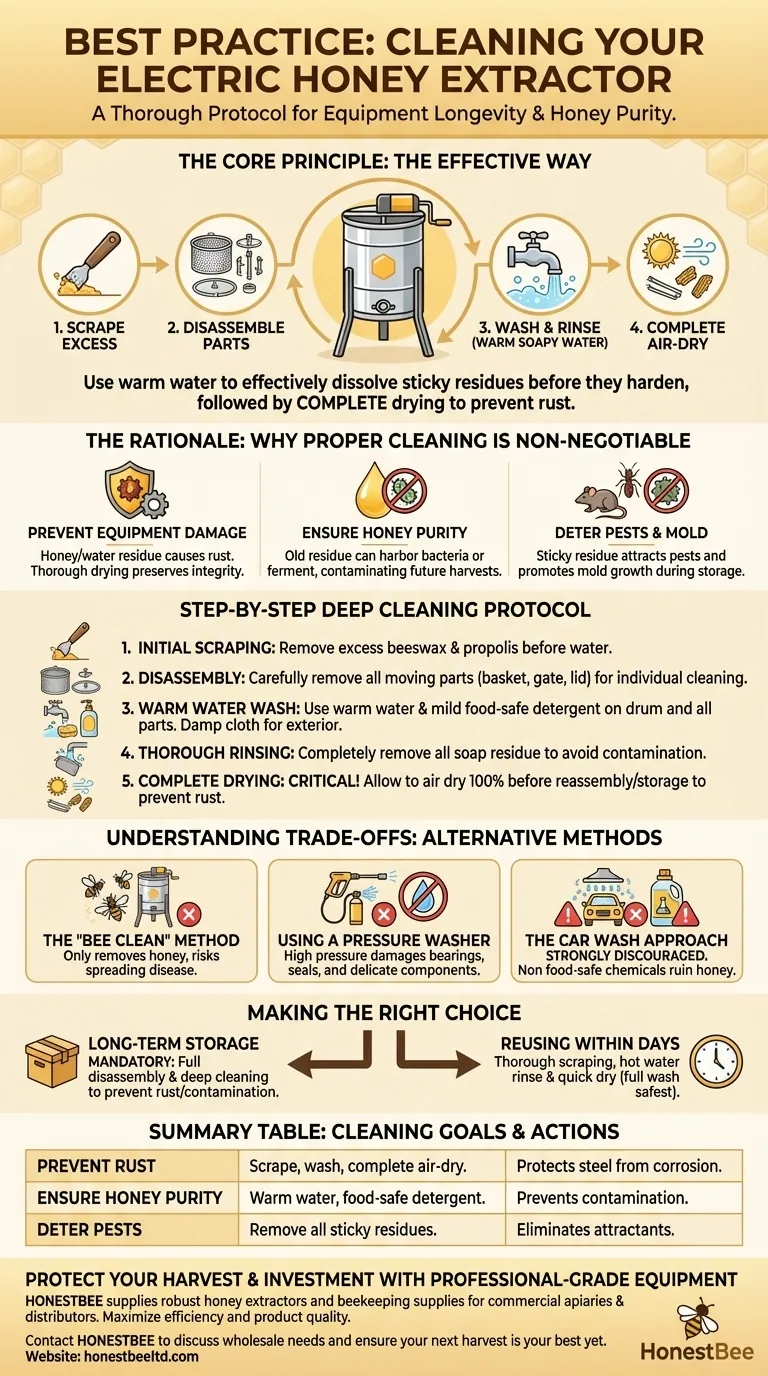The most effective way to clean an electric honey extractor is to first scrape out excess wax and propolis, then disassemble all removable parts. Wash the components and the extractor's interior with warm, soapy water, followed by a thorough rinse and complete air-drying before reassembly and storage.
Cleaning your honey extractor isn't just about tidiness—it's a critical step for preventing rust, avoiding contamination in future harvests, and ensuring the longevity of your equipment. The core principle is to use warm water to efficiently remove all sticky residues before they harden.

The Rationale: Why Proper Cleaning is Non-Negotiable
Proper cleaning is a preventative measure. Skipping this step can lead to significant problems that compromise both your equipment and your honey.
Preventing Equipment Damage
Honey and water residue left in a steel extractor can lead to rust and corrosion over time. Thoroughly drying every component is arguably the most critical step for preserving the machine's integrity.
Ensuring Honey Purity
Old honey, wax, and propolis can harbor bacteria or ferment. This can contaminate your next harvest, altering its taste and quality. A pristine extractor ensures a pure product.
Deterring Pests and Mold
Sticky residues are a powerful attractant for ants, mice, and other pests during storage. A completely clean and dry environment eliminates this risk and prevents mold growth.
The Step-by-Step Deep Cleaning Protocol
Follow this methodical process after your final extraction of the season for best results. This ensures your equipment is perfectly prepared for long-term storage.
Step 1: Initial Scraping
Before introducing any water, use a hive tool or uncapping knife to scrape out as much excess beeswax and propolis as possible. This makes the washing stage significantly easier.
Step 2: Disassembly
Carefully remove all moving parts. This typically includes the internal basket or frames, the honey gate, and sometimes the lid. Cleaning each component individually is the only way to ensure a truly thorough job.
Step 3: The Warm Water Wash
Wash the extractor drum and all disassembled parts with warm water and a mild, food-safe detergent. Warm water is ideal because it effectively softens and dissolves honey and wax without melting wax into a mess that can be caused by excessively hot water.
For the exterior, a damp cloth is usually sufficient to wipe away any dust or honey spills.
Step 4: Thorough Rinsing
Rinse every component completely to remove all soap residue. Any remaining detergent could contaminate your next batch of honey.
Step 5: Complete Drying
This is the most crucial step for preventing rust. Allow the extractor and all its parts to air dry completely. Placing them in the sun on a warm day can accelerate this process. Do not reassemble or store the unit until you are certain it is 100% dry.
Understanding the Trade-offs: Alternative Methods
While the manual deep clean is the gold standard, beekeepers sometimes consider other methods. It's important to understand their limitations.
The "Bee Clean" Method
Some beekeepers leave the extractor outside for the bees to clean. While natural, this method only removes the honey and is not a true deep clean. Crucially, it also carries a significant risk of spreading diseases between hives.
Using a Pressure Washer
A pressure washer can be fast, but it is a high-risk approach. The intense pressure can damage the extractor's bearings, motor seals, and more delicate components. It can also force water into crevices where it may not dry, leading to rust.
The Car Wash Approach
Taking an extractor to a car wash is strongly discouraged. The soaps and waxes used in these facilities are not food-safe and can introduce chemical contaminants that will ruin your honey.
Making the Right Choice for Your Goal
Your cleaning approach depends on when you plan to use the extractor next.
- If your primary focus is long-term, end-of-season storage: A full disassembly and the complete deep cleaning protocol is mandatory to prevent rust and contamination.
- If your primary focus is reusing the extractor within a day or two: A thorough scraping followed by a hot water rinse and quick dry may be sufficient, but a full wash is always the safest practice.
Ultimately, a well-maintained extractor is a vital asset for any beekeeper, ensuring the purity of your honey and the health of your investment for years to come.
Summary Table:
| Cleaning Goal | Key Action | Why It's Important |
|---|---|---|
| Prevent Rust | Thorough scraping, washing, and complete air-drying. | Protects steel components from corrosion and damage. |
| Ensure Honey Purity | Use warm water and mild, food-safe detergent. | Prevents contamination from old honey, wax, and bacteria. |
| Deter Pests | Remove all sticky residues before storage. | Eliminates attractants for ants, mice, and mold. |
Protect Your Harvest and Investment with Professional-Grade Equipment
A clean extractor is the foundation of pure honey. Ensure your operation runs smoothly with durable, easy-to-clean equipment designed for commercial beekeepers and distributors.
HONESTBEE supplies robust honey extractors and a full range of beekeeping supplies through our wholesale-focused operations. We help commercial apiaries and equipment distributors maximize efficiency and product quality.
Contact HONESTBEE today to discuss your wholesale needs and ensure your next harvest is your best yet.
Visual Guide

Related Products
- 6 Frame Manual Stainless Steel Honey Extractor Beekeeping Equipment
- HONESTBEE 72 Frame Industrial Electric Honey Extractor for Beekeeping
- Commercial Electric 12 Frame Honey Extractor Spinner Motorized Honey Extractor
- 40 Frame Commercial Electric Honey Extractor for Beekeeping
- HONESTBEE 3-Frame Manual Acrylic Honey Extractor
People Also Ask
- What are the key stages of honey extraction? A Complete Guide for Beekeepers
- What tips can maximize honey extraction efficiency? Unlock Higher Yields and Purer Honey
- What are the differences between manual and automatic honey extractors? Choose the Right Tool for Your Apiary
- What is the relationship between beeswax harvesting and honey extraction? An Inseparable Process Explained
- Which type of extractor is more suitable for hobbyists or small-scale beekeepers? Find the Perfect Fit for Your Apiary



















